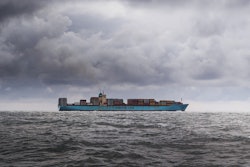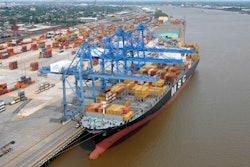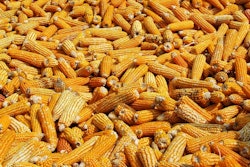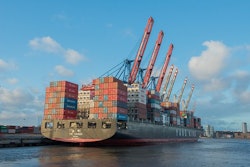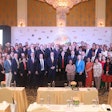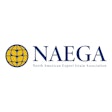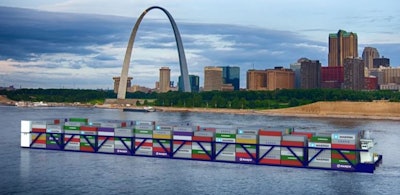
A new, innovative maritime vessel offers the potential to transport soybeans and other agricultural products via shipping containers along the nation’s inland waterway system to export facilities near the Gulf of Mexico. If realized, this new supply chain will enable farmers and local elevators to more directly access international customers.
American Patriot Holding (APH) has developed a patented vessel design that would enable the transport of shipping containers throughout the nation’s inland waterway system.
The company’s larger Liner vessels will be able to transport 2,375 20-foot length containers (TEUs) in a liner service between Plaquemines Port Harbor and Terminal District (PPHTD) – the port complex along the lower Mississippi River closest to the Gulf of Mexico – and both Memphis and St. Louis.
Expected roundtrip service between PPHTD and Memphis is seven days and ten days between PPHTD and St. Louis. The vessels will be able to travel at 13 miles/hour with virtually no wake – mitigating shoreline erosion throughout the inland waterway system. A traditional barge flotilla will travel up river between four and five miles per hour.
In addition to the liner service to Memphis and St. Louis, APH has designed a smaller Hybrid vessel capable of transiting the lock and dam portion of the inland waterway system.
These vessels – able to transport approximately 1,700 TEUs – will provide access to regions and communities located along the Mississippi, Illinois, Ohio, and Arkansas rivers. Future service for areas along the upper Mississippi River is currently under evaluation.
In an effort to determine the economic feasibility of exporting soybeans and other agricultural products via this new container on vessel approach, the Soy Transportation Coalition (STC) released a report, performed by Informa Economics IEG, comparing the cost, speed, and quality preservation of this potential alternative to the currently utilized options of shipping containers via rail to the West Coast and bulk barge transportation to Mississippi Gulf export terminals.
The analysis builds upon earlier, foundational research commissioned by the Illinois Soybean Association highlighting the viability of an all-water routing of containerized agricultural products.
“It should be the goal of the Soy Transportation Coalition (STC) to explore opportunities to remove logistical steps between the farmers growing soybeans and the ultimate customers purchasing them,” says Gerry Hayden, a soybean farmer from Calhoun, KY, and chairman of the STC. “Every step that is removed allows farmers to realize a higher value for what is produced. We are therefore excited to explore this new approach for transporting containers along our nation’s inland waterway system.”
The research concluded that transporting soybeans from St. Louis via bulk barge to an ocean vessel at a Mississippi Gulf export terminal and onto a customer in Shanghai, China, would cost $79.80 per metric ton. Loading soybeans into a container near St. Louis, transporting it via rail to the West Coast, and finally an ocean vessel journey to Shanghai would cost $197.87 per metric ton.
The proposed APH Liner service would transport soybeans from St. Louis via container to an ocean vessel at PPHTD and onto a customer in Shanghai at a cost of $108.88 per metric ton – a 45% cost savings compared to containerized shipping through the West Coast.
The speed of the APH vessel will enable shipments of soybeans and other agricultural products to reach the Mississippi Gulf export terminal six days faster than bulk barge shipments. Given the increased congestion on the West Coast, the APH vessel will be able to depart the export facility at PPHTD 14 days faster than containerized shipments via rail to West Coast facilities. Combining the transit times of the three options both to the export facilities and from the export facilities to a customer in Shanghai, the APH option will enjoy a 14 day advantage over the bulk barge option and will be six days faster than containerized shipping via the West Coast.
“Our research highlights this innovative approach can provide a cost-effective, fast, and secure transportation option to our international customers,” explains Mike Steenhoek, executive director of the Soy Transportation Coalition. “As we interact with our international customers, we increasingly hear a desire for being able to source soybeans and agricultural products more directly from more localized elevators and even specific farmers.
"Our customers also routinely express a desire for greater quality preservation and smaller shipping quantities that conform better with the scale of their specific operations," he continues. "Exploring this new model of containerized shipping via the inland waterway system is a response to this growing customer sentiment. We look forward to utilizing our research to further introduce farmers and agricultural shippers to this innovative opportunity.”
The Soy Transportation Coalition will be partnering with APH and PPHTD in establishing working groups among communities and regions along the inland waterway system that are well positioned to benefit from this potentially new supply chain.
To inquire further about the working groups, contact Mike Steenhoek at 515-727-0665 or [email protected].


